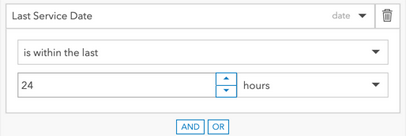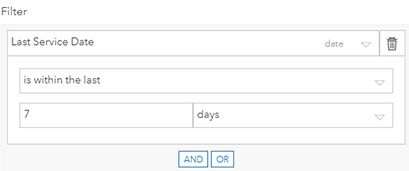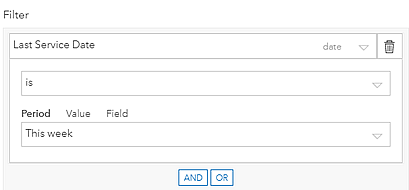Dates are composed of two parts: date and time. In general, when configuring a filter condition with a date field type, there are two types of conditions you can create: fixed date and relative date.
Note:
To filter features by date, the layer must support standardized SQL functions.
When filtering dates, enter the time component in your local time zone. Behind the scenes, the dashboard searches the target layer's properties for time zone information. If time zone information is found, queries are sent in that time zone. This may involve converting the input values to the target layer's time zone. If time zone information is not found, the dashboard converts the input values to coordinated universal time (UTC) before they are sent.
Tip:
- Dates in hosted feature layers are always stored in UTC. If you specify a source time zone when publishing a hosted feature layer, date values are converted to UTC during the hosting process.
- ArcGIS Pro and ArcMap 10.4. and later allow time zone information to be set when publishing a service that references data stored in a registered enterprise database or geodatabase.
Fixed-date conditions
Fixed-date filter conditions include a specific date value. You can enter this value can by choosing a date from the date picker on the Value tab or by choosing another date field on the Field tab. Choosing a date field works in the same way as entering a specific date value that can update based on data changes to the field.

Note:
The Field tab only appears if the element's layer includes more than one date field.
A fixed-date filter condition can only be created with the following operators:
- is
- is not
- is before
- is or is before
- is after
- is or is after
Note:
You can also create a fixed-date filter condition with a range of fixed dates by creating individual filters with fixed dates and combining them using logical operators.
Relative-date conditions
Relative-date filter conditions include a range of date values. The range can be anchored to or include the current moment in time (now), or it can be a predefined period (for example, last week). The range or anchor type you can enter depends on the operator you choose.
| Operator | Anchor type |
|---|---|
is within the last | Now |
is before the last | Now |
is within the next | Now |
is after the next | Now |
is | Now or predefined |
is not | Now or predefined |
is before | Now or predefined |
is or is before | Predefined |
is after | Now or predefined |
is or is after | Predefined |
Anchored to now
The benefit of using date ranges anchored to now is that they allow elements to refresh at the rate that data might be changing. For example, an indicator configured to display data that is within the last 30 minutes can potentially show different data every minute if its layer also refreshes that often. However, an indicator that shows data from yesterday will only show different data after today's date has changed (that is, after midnight) regardless of the layer's refresh interval.
When selecting an operator associated with an anchor type of now, you are prompted to specify a unit multiplier (N) as well as a time unit (for example, hour, minute, or second) or calendar unit (for example, day, month, quarter, or year).
Note:
Unit multipliers must always be whole values. For example, if you want to filter for half a day, instead of 0.5 days, your filter should be 12 hours.
Time units are measured from now (the current time). For example, if the time range is within the last 24 hours, the unit multiplier is 24 and the unit is hours. The range starts 24 hours before now and continues until now.

Calendar units include full days, from 12:00:00 a.m. to 11:59:59 p.m. for each day in the range, relative to the user's local time zone. For example, if the date range is within the last 7 days, the unit multiplier is 7 and the unit is day. The range starts at 12:00:00 a.m. 7 days before today.

| Operator | Time unit | Description |
|---|---|---|
is within the last | seconds | N seconds before now. |
minutes | N minutes before now. | |
hours | N hours before now. | |
days | Starts at 12:00:00 a.m. N days before the current day up to now. | |
weeks | Starts at 12:00:00 a.m. on the first day of the week N weeks before now. | |
months | Starts at 12:00:00 a.m. on the first day of the month N months before now. | |
quarters | Starts at 12:00:00 a.m. on the first day of the quarter N quarters before now. | |
years | Starts at 12:00:00 a.m. on the first day of the year N years before now. | |
is before the last | seconds | N seconds before now and continues indefinitely. |
minutes | N minutes before now and continues indefinitely. | |
hours | N hours before now and continues indefinitely. | |
days | Starts at 12:00:00 a.m. N days before the current day and continues indefinitely. | |
weeks | Starts at 12:00:00 a.m. N weeks before the current week and continues indefinitely. | |
months | Starts at 12:00:00 a.m. N months before the current month and continues indefinitely. | |
quarters | Starts at 12:00:00 a.m. N quarters before the current quarter and continues indefinitely. | |
years | Starts at 12:00:00 a.m. N years before the current year and continues indefinitely. | |
is within the next | seconds | Starts now and continues N seconds from now. |
minutes | Starts now and continues N minutes from now. | |
hours | Starts now and continues N hours from now. | |
days | Starts now and continues until 11:59:59 p.m. N days from now. | |
weeks | Starts now and continues until 11:59.59 p.m. N weeks from now. | |
months | Starts now and continues until 11:59:59 p.m. on the last day of the month, N months from now. | |
quarters | Starts now and continues until 11:59:59 p.m. on the last day of the quarter, N quarters from now. | |
years | Starts now and continues until 11:59:59 p.m. on the last day of the year, N years from now. | |
is after the next | seconds | N seconds after now continues indefinitely. |
minutes | N minutes after now and continues indefinitely. | |
hours | N hours now and continues indefinitely. | |
days | Starts at 12:00:00 a.m. N days after the current day and continues indefinitely. | |
weeks | Starts at 12:00:00 a.m. N weeks after the current week and continues indefinitely. | |
months | Starts at 12:00:00 a.m. N months after the current month and continues indefinitely. | |
quarters | Starts at 12:00:00 a.m. N quarters after the current quarter and continues indefinitely. | |
years | Starts at 12:00:00 a.m. N years after the current year and continues indefinitely. | |
is before | Now | Includes everything up to now. |
is after | Now | Includes everything from now. |
is | Year to date | Starts at 12:00:00 a.m. January 1 of the current year and continues to now. |
is not | Year to date | Excludes everything in the current year to date. The current year to date starts at 12:00:00 a.m. January 1 of the current year and continues to now. |
Anchored to a predefined period
Using date ranges anchored to a predefined period is appropriate when you don't need the data to update as frequently as the layer refreshes.
When selecting an operator associated with a predefined anchor type, you need to specify an interval on the Period tab.

These periods are based on the following units. Note that start and end times are always based on your local time zone.
- Day—A day starts at 12:00:00 a.m. and continues for 24 hours, ending at 11:59:59 p.m. On a 24-hour clock, a day starts at 00:00:00 and continues for 24 hours, ending at 23:59:59.
- Week—A week starts at 12:00:00 a.m. on the first day of the week and continues for seven consecutive days, ending at 11:59:59 p.m. on the seventh day.
Note:
The first day of the week is determined by the calendar on your device. For example, a week may be Sunday to Saturday or Monday to Sunday.
- Month—A month is defined according to the Gregorian calendar. Each month starts at 12:00:00 a.m. (local time) on the first day of the month and continues until 11:59:59 p.m. (local time) on the last day of the month.
- Quarter—Each year is divided into quarters that are three months long, as described below.
- 1st quarter—January through March
- 2nd quarter—April through June
- 3rd quarter—July through September
- 4th quarter—October through December
- Year—A year is the 12-month time period beginning at 12:00:00 a.m. on January 1 and ending at 11:59:59 p.m. on December 31.
| Predefined time period | Description |
|---|---|
Today | Starts at 12:00:00 a.m. on the current day and continues for 24 hours. |
Yesterday | Starts at 12:00:00 a.m. on the day before the current day and continues for 24 hours. |
Tomorrow | Starts at 12:00:00 a.m. on the day after the current day and continues for 24 hours. |
This week | Starts at 12:00:00 a.m. on the first day of the current week and continues for seven days. |
Last week | The 7-day period that ends immediately before the current week starts. Last week starts at 12:00:00 a.m. on the first day of the week that precedes the current week and continues for 7 days. |
Next week | The 7-day period that starts immediately after the current week ends. Next week starts at 12:00:00 a.m. the first day of the week after the current week and continues for 7 days. |
This month | Starts at 12:00:00 a.m. on the first day of the current month and continues until 11:59:59 p.m. on the last day of the month. |
Last month | Starts at 12:00:00 a.m. on the first day of the month that precedes the current month and continues until 11:59:59 p.m. on the last day of the month. |
Next month | Starts at 12:00:00 a.m. on the first day of the month that follows the current month and continues until 11:59:59 p.m. on the last day of the month. |
This quarter | Starts at 12:00:00 a.m. on the first day of the current quarter and continues for three months, ending at 11:59:59 p.m. on the last day of the quarter. |
Last quarter | Starts at 12:00:00 a.m. on the first day of the quarter immediately preceding the current quarter and continues for three months, ending at 11:59:59 p.m. on the last day of the quarter. |
Next quarter | Starts at 12:00:00 a.m. on the first day of the quarter after the current quarter ends, and continues for three months, ending at 11:59:59 p.m. on the last day of that quarter. |
This year | Starts at 12:00:00 a.m. January 1 of the current year and continues for 12 months (through 11:59:59 p.m. on December 31). |
Last year | Starts at 12:00:00 a.m. January 1 of the year immediately preceding the current year and continues for 12 months (through 11:59:59 p.m. on December 31). |
Next year | Starts at 12:00:00 a.m. January 1 of the year immediately following the current year and continues for 12 months (through 11:59:59 p.m. on December 31). |